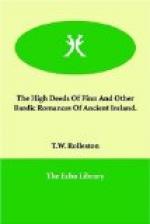Of course this barbaric cruelty is common to all early periods in every nation; and, whenever fierce passion is aroused, to civilised nations also. What is remarkable in the Irish tales is the contemporary tenderness. The Vikings were as savage as the Irish, but the savagery is not mingled with the Irish tenderness. At last, when we pass from the Hero Cycle into the Cycle of Finn, there is scarcely any of the ancient brutality to be found in the host of romantic stories which gather round the chivalry of the Fenians.
There are other characteristics of these old tales on which I must dwell. The first is the extra-ordinary love of colour. This is not a characteristic of the early German, English or Scandinavian poems and tales. Its remarkable presence in Scottish poetry, at a time when it is scarcely to be found in English literature, I have traced elsewhere to the large admixture of Celtic blood in the Lowlands of Scotland. In early Irish work it is to be found everywhere. In descriptions of Nature, which chiefly appear in the Fenian Cycle and in Christian times, colour is not as much dwelt on as we should expect, for nowhere that I have seen is it more delicate and varied than under the Irish atmosphere. Yet, again and again, the amber colour of the streams as they come from the boglands, and the crimson and gold of the sunsetting, and the changing green of the trees, and the blue as it varies and settles down on the mountains when they go to their rest, and the green crystal of the sea in calm and the dark purple of it in storm, and the white foam of the waves when they grow black in the squall, and the brown of the moors, and the yellow and rose and crimson of the flowers, and many another interchanging of colour, are seen and spoken of as if it were a common thing always to dwell on colour. This literary custom I do not find in any other Western literature. It is even more remarkable in the descriptions of the dress and weapons of the warriors and kings. They blaze with colour; and as gold was plentiful in Ireland in those far-off days, yellow and red are continually flashing in and out of the blue and green and rich purple of their dress. The women are dressed in as rich colours as the men. When Eochy met Etain by the spring of pure water, as told in this book, she must have flashed in the sunlight like a great jewel. Then, the halls where they met and the houses of the kings are represented as glorious with colour, painted in rich patterns, hung with woven cloths dyed deep with crimson and blue and green and yellow. The common things in use, eating and drinking implements, the bags they carry, the bed-clothing, the chess-men, the tables, are embroidered or chased or set with red carbuncles or white stones or with interlacing of gold. Colour is everywhere and everywhere loved. And where colour is loved the arts flourish, as the decorative arts flourished in Ireland.




